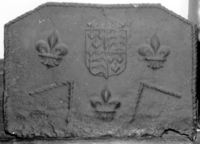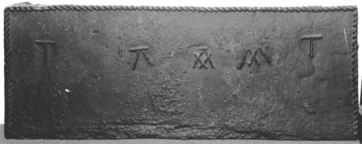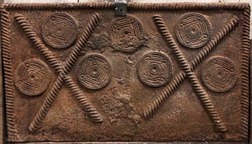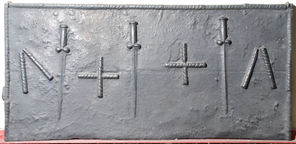-
124
Description: Canted rectangle; twisted rope edging (top and sides); top centre, crowned Tudor royal shield; fleur de lys on each side and below; slanting, inverted 'V' of twisted rope on each side of lower fleur.
Notes: One of a large series of firebacks incorporating Tudor heraldic stamps; the 'V' shapes may have apotropaic significance.
Arms: Tudor royal arms of England
- Decoration tags:
- rectangular with canted top corners (shape)
- rope (edging)
- simple stamps
- carved stamps
- heraldic
- apotropaic
- armorial
- objects
Manufactured: in the mid-16th century in the Weald area of England.
Current location: Hastings Museum and Art Gallery, John's Place, Bohemia Road, Hastings, East Sussex, England.
Museum number: HASMG: 1904.32 (part of the Hastings Museum museum group)
- Attached to series:
- Royal series
-
169
Description: Rectangular; twisted rope edging (top and sides); inscription made of short lengths of twisted rope, irregularly spaced across upper middle, central device formed of a Tudor 'A' with overstamped 'V'.
Notes: It is not clear if the central device is a monogram, or if it might have apotropaic significance.
Inscription: T A M T
- Decoration tags:
- rectangular (shape)
- rope (edging)
- simple stamps
- apotropaic
- text
- objects
Manufactured: in the early- to mid-16th century in the Weald area of England.
Current location: Hastings Museum and Art Gallery, John's Place, Bohemia Road, Hastings, East Sussex, England.
Museum number: HASMG: 1911.60.7 (part of the Hastings Museum museum group)
Citation: Page, S. & Wallace, M. (eds.), 2018, Spellbound (Oxford, Ashmolean Museum), p. 72.
- Attached to series:
- Rope design firebacks
-
174
Description: Rectangular; plain plate with central crossed-square rope pattern with crosses at the corner and top; on each side a rectangular stamp with swirled tendril, serpent and demi-cup decoration.
Notes: The crossed square was an alchemistic symbol for iron vitriol (i.e. ferrous sulphate or copperas), but the crosses at the extremities may indicate other symbolism or none; similar patterns are found on other firebacks of a group that may have been associated with Pounsley furnace, Sussex. The repeated panel at the top appears to have been formed using a mould for a section of a plasterwork frieze, resulting in an intaglio impression (approx 395 x 142mm or 15½ x 5½ in.) as opposed to the normal bas-relief; this is very unusual on a fireback. The style of the mould dates from the Elizabethan or Jacobean period. The stubs on the bottom edge are likely to have been the remains of runners where the molten iron entered the mould. Recovered from a property in Burwash, Sussex, in 1910.
- Decoration tags:
- rectangular (shape)
- none (edging)
- simple stamps
- apotropaic
- animals
- objects
Manufactured: in the late-16th to early-17th century possibly at Pounsley Furnace, Framfield in the Weald area of England.
Current location: Hastings Museum and Art Gallery, John's Place, Bohemia Road, Hastings, East Sussex, England.
Museum number: HASMG: 1910.26.1 (part of the Hastings Museum museum group)
Citation: Baines, J. M., 1958, Wealden Firebacks (Hastings Museum).
- Attached to series:
- Pounsley series
- Miscellaneous stamp firebacks
-
912
Description: Rectangular; twisted rope edging (top and sides); impression of the end of a firedog repeated three times, one upright in centre, two diagonally inverted with feet angled towards top centre; a large saltire of twisted rope in each top corner, a small saltire, of twisted rope and dowel, on either side of top of central firedog; cross of twisted rope below right hand corner saltire; lower centre, two angled rope lengths either side of central firedog. At the bottom, and outside the feet of the central firedog, two excrescences formed by the pouring of the metal.
Notes: A well-preserved example with an unusual arrangement of the firedog stamp; formerly (c.1886) in the Warbill-in-Tun inn, Warbleton, Sussex.
- Decoration tags:
- rectangular (shape)
- rope (edging)
- simple stamps
- apotropaic
- objects
Manufactured: in the mid- to late-16th century in the Weald area of England.
Current location: in private hands, Heathfield, East Sussex, England.
Citation: Balcomb, J. T., Nov. 1886, 'An Extinct Sussex Art', The Art Journal, pp. 337-340.
- Attached to series:
- Firedog stamp firebacks
- Metalware stamp firebacks
-
921
Description: Canted rectangle; twisted rope edging (top and sides); central arrow-shaped design formed of three repeated rope lengths.
Notes: The arrow design probably has an apotropaic (evil-averting) purpose, perhaps intended as the initials VV for 'virgo virginum'.
- Decoration tags:
- rectangular with canted top corners (shape)
- rope (edging)
- simple stamps
- apotropaic
- objects
Manufactured: in the 16th century in the Weald area of England.
Current location: in private hands, Heathfield, East Sussex, England.
- Attached to series:
- Rope design firebacks
-
1118
Description: Rectangular; twisted rope edging (top and sides); initials in top corners; below the initials, a saltire formed of possibly two straight lengths of twisted rope.
Notes: The saltire is likely to have an apotropaic purpose; the hollows in the risers of the letter 'H' and the end of the left line of the saltire may have been formed by gas bubbles in the molten iron during casting.
Inscription: N H
- Decoration tags:
- rectangular (shape)
- rope (edging)
- simple stamps
- individual letters
- apotropaic
- text
Manufactured: in the early- to mid-17th century in England.
Current location: in private hands, Isleworth, London, England.
- Attached to series:
- Rope design firebacks
-
1172
Description: Rectangular; twisted rope edging (top and sides); to each side, two saltires formed of crossed lengths of twisted rope; in between, and repeated seven times, a circular stamp decorated in low relief with a central disc perforated in the centre, surrounded by a circle inside a square looped at each corner, the sides of which are echoed twice on each side; the stamps are arranged in two rows, of three and four, in the upper part of the plate.
Notes: A boldly cast fireback with an excrescence top centre caused by disturbance of the casting sand by the pouring of the iron.
- Decoration tags:
- rectangular (shape)
- rope (edging)
- simple stamps
- carved stamps
- apotropaic
- objects
Manufactured: in the late-16th to early-17th century possibly in the Weald area of England.
Current location: Retrouvius, 1016 Harrow Road, Kensal Green, Brent, London, England.
- Attached to series:
- Food mould stamp firebacks
- Rope design firebacks
-
1083
Description: Arched rectangular shape; fillet edging (top and sides); twisted rope cross in centre of arch; fillet-edged square below arch containing initials of uneven size; along the top, a line of five quatrefoils on each side of the initials; below, two symmetrically carved roundels and associated spandrels, each with a central flower.
Notes: The quatrefoils and roundels are likely to have been part of a redundant, probably medieval, furniture panel, perhaps from a chest. The life-size rubbing, reinforced with ink, is by W. R. Lethaby. The fireback was formerly property of the artist John Callcott Horsley RA (1817-1903) at Wilsley Green, Cranbrook, Kent.
Inscription: PC
- Decoration tags:
- rectangular with round arch (shape)
- fillet (edging)
- carved pattern panels
- apotropaic
- text
- objects
Manufactured: in the mid- to late-16th century possibly in the Weald area of England.
Current location: Victoria & Albert Museum, Cromwell Road, Kensington & Chelsea, London, England.
Museum number: 3267-1932 (part of the Victoria & Albert Museum museum group)
Citation: Lethaby, W. R., 1 Oct 1926, 'English Cast Iron - I', The Builder, 131, no. 4365, pp. 537-8.
- Attached to series:
- Miscellaneous pattern firebacks
-
372
Description: Rectangular with canted top corners; twisted rope edging all round except on bottom; three impressions of two circular wafering irons: the central one with invected edge, a heart surmounted by a cross beneath which scroll-work is arranged symmetrically, inscription around edge; the two outer stamps comprise a central motif of four hearts arranged in a cross shape, their points facing the centre, within two concentric bands decorated with lace-like patterns. Above each of the two outer stamps is a simple four-pointed cross shape formed from short lengths of twisted rope.
Notes: The use of wafering irons or butter prints as stamps in casting firebacks is infrequent. Formerly part of the J. H. Every collection.
Inscription: ...N:YOU:NOT: REIVE:MY:HERT:IS:YOURES / [?]1562
- Decoration tags:
- rectangular with canted top corners (shape)
- rope (edging)
- simple stamps
- apotropaic
- text
- objects
Manufactured: in 1562 in the Weald area of England.
Current location: Anne of Cleves House, Southover High Street, Lewes, East Sussex, England.
Museum number: 1944.24.048 (part of the Sussex Archaeological Society museum group)
Citation: Hughes, G. B., 1960, Collecting Antiques (London, Country Life), pp. 85-93.
Citation: Hughes, G. B., 21 Apr 1955, 'Old English Firebacks', Country Life, 117, pp. 1056-60.
Citation: Hughes, G. B., May 1940, 'Old English Firebacks', Apollo, 31, 185, pp. 117-120.
- Attached to series:
- Food mould stamp firebacks
- Heart cross stamp series
-
373
Description: Rectangular, edged with twisted leather lengths on top and sides; a ballock dagger with hollow-ground cruciform blade, point down, impressed vertically three times and evenly spaced across the width of the back; between each, two short lengths of twisted leather, arranged in a cross; at either end, the same short lengths of dowel arranged in an inverted ‘V’.
Notes: The dagger (length approx. 38cm) dates from c1575-1625. The probable use of twisted leather is seen occasionally on other firebacks. The grouping of three daggers may also have apotropaic significance in relation to the Trinity.
- Decoration tags:
- rectangular (shape)
- twisted leather (edging)
- simple stamps
- planklines
- apotropaic
- objects
Manufactured: in the late-16th to early-17th century in the Weald area of England.
Current location: Anne of Cleves House, Southover High Street, Lewes, East Sussex, England.
Museum number: 1944.24.035 (part of the Sussex Archaeological Society museum group)
- Attached to series:
- Knife & Dagger stamp firebacks









